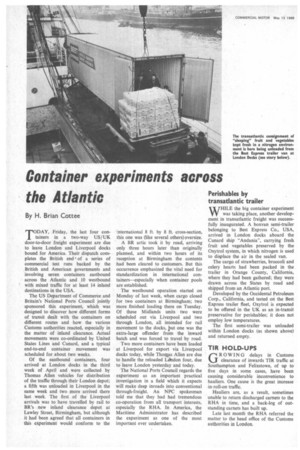Container experiments across the Atlantic
Page 100

If you've noticed an error in this article please click here to report it so we can fix it.
By H. Brian Cottee
T?TODAY. Friday, the last four containers in a two-way US/UK door-to-door freight experiment are due to leave London and Liverpool docks bound for America. Their dispatch completes the British end • of a series of commercial test runs backed by the British and American governments and involving seven containers eastbound across the Atlantic and 10 westbound with mixed traffic for at least 14 inland destinations in the USA.
The US Department of Commerce and Britain's National Ports Council jointly sponsored this experiment, which was designed to discover how different forms of transit dealt with the containers on different routes and how the various Customs authorities reacted, especially in the matter of inland clearance. Actual movements were co-ordinated by United States Lines and Cunard, and a typical end-to-end container movement was scheduled for about two weeks.
Of the eastbound containers, four arrived at London docks in the third week of April and were collected by Thomas Allen vehicles for distribution of the traffic through their London depot; a fifth was unloaded in Liverpool in the same week and two more arrived there last week. The first of the Liverpool arrivals was to have travelled by rail to BR's • new inland clearance depot at Lawley Street, Birmingham, but although it had been agreed that all containers in this experiment would conform to the international 8 ft. by 8 ft. cross-section, this one was (like several others)oversize.
A BR artic took it by road, arriving only three hours later than originally planned, and within two hours of its reception at Birmingham the contents had been cleared to customers. But this occurrence emphasized the vital need for standardization in international containers—especially when container pools are established.
The westbound operation started on Monday of last week, when cargo closed for two containers at Birmingham; two more finished loading there on Tuesday. Of these Midlands units two were scheduled out via Liverpool and two through London, all intended for rail movement to the docks, put one was the extra-large offender from the inward batch and was forced to travel by road.
Two more containers have been loaded at Liverpool for export via Liverpool docks today, while Thonaas Allen are due to handle the reloaded London four, due to leave London yesterday and today.
The National Ports Council regards the experiment as an important practical investigation in a field which it expects will make deep inroads into conventional through-freight. An NPC spokesman told me that they had had tremendous co-operation from an transport interests, especially the RHA. In America, the Maritime Administrator has described the experiment as one of the most important ever undertaken.




















































































































































